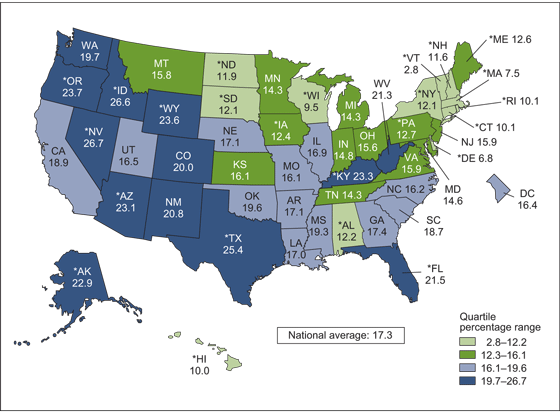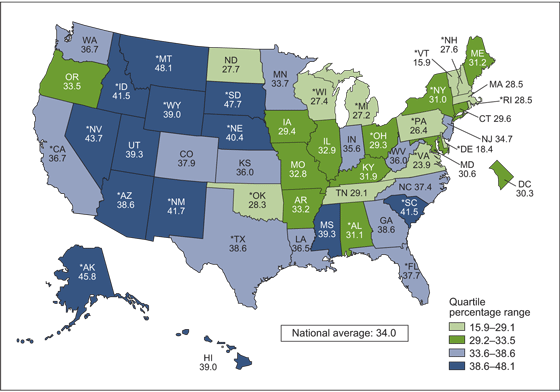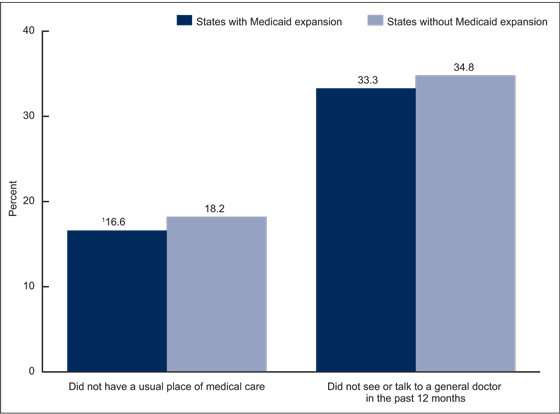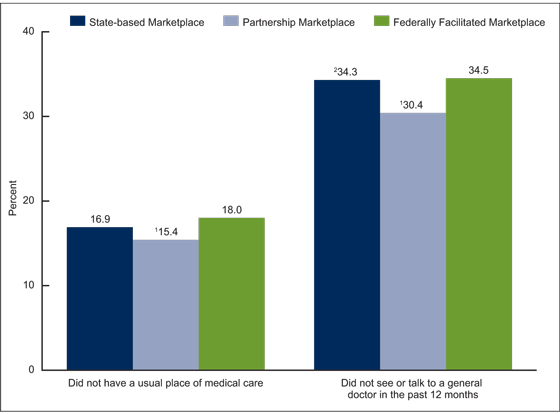State Variation in Health Care Service Utilization: United States, 2014
On This Page
- Key findings
- Did the percentage of adults without a usual place of medical care vary by state?
- Did the percentage of adults who had not seen or talked to a general doctor in the past 12 months vary by state?
- Did the percentage of adults without a usual place of medical care or who had not seen or talked to a general doctor in the past 12 months vary by state Medicaid expansion status?
- Did the percentage of adults without a usual place of medical care or who had not seen or talked to a general doctor in the past 12 months vary by type of state Health Insurance Marketplace?
- Summary
- Definitions
- Data source and methods
- About the authors
- References
- Suggested citation
NCHS Data Brief No. 245, May 2016
PDF Version (377 KB)
Lindsey I. Black, M.P.H., Jeannine S. Schiller, M.P.H.
Key findings
Data from the National Health Interview Survey, 2014
- The percentage of adults without a usual place of medical care ranged from 2.8% in Vermont to 26.7% in Nevada.
- The percentage of adults who did not have a general doctor visit in the past 12 months ranged from 15.9% in Vermont to 48.1% in Montana.
- The percentage of adults without a usual place of medical care was lower in states that expanded Medicaid compared with nonexpansion states.
- The percentage of adults without a usual place of medical care or who did not see a general doctor in the past 12 months was lower in states with partnership marketplaces compared with Federally Facilitated Marketplace states.
State-level differences in the percentage of uninsured Americans, along with other factors, may affect health care access and utilization (1–4). This report examines the prevalence of two health care utilization measures among adults aged 18–64 by state. Additionally, differences by Medicaid expansion status and state Health Insurance Marketplace type are examined. Estimates are based on the 2014 National Health Interview Survey, a nationally representative sample of the noninstitutionalized U.S. population.
Keywords: health services, Medicaid expansion, Health Insurance Marketplace, National Health Interview Survey
Did the percentage of adults without a usual place of medical care vary by state?
In 2014, 17.3% of adults aged 18–64 did not have a usual place of medical care. The percentage ranged from 2.8% in Vermont to 26.7% in Nevada (Figure 1).
Nine states (Nevada, Idaho, Texas, Oregon, Wyoming, Kentucky, Arizona, Alaska, and Florida) had a higher percentage of adults without a usual place of medical care compared with the national average (17.3%).
Vermont, Delaware, Massachusetts, Wisconsin, Hawaii, Connecticut, Rhode Island, New Hampshire, North Dakota, South Dakota, New York, Alabama, Iowa, Maine, and Pennsylvania had a lower percentage of adults without a usual place of medical care compared with the national average.
Figure 1. Percentage of adults aged 18–64 without a usual place of medical care, by state: United States, 2014

*Significantly different from the national average (p < 0.05).
NOTE: Access data table for Figure 1.
SOURCE: NCHS, National Health Interview Survey, 2014.
Did the percentage of adults who had not seen or talked to a general doctor in the past 12 months vary by state?
In 2014, 34.0% of adults aged 18–64 had not seen or talked to a general doctor in the past 12 months. The percentage ranged from 15.9% in Vermont to 48.1% in Montana (Figure 2).
Eleven states (Montana, South Dakota, Alaska, Nevada, New Mexico, South Carolina, Idaho, Nebraska, Texas, Florida, and California) had a higher percentage of adults who had not seen or talked to a general doctor in the past 12 months compared with the national average (34.0%).
Vermont, Delaware, Virginia, Pennsylvania, Michigan, Wisconsin, New Hampshire, Oklahoma, and Ohio had a lower percentage of adults who had not seen or talked to a general doctor in the past 12 months compared with the national average.
Figure 2. Percentage of adults aged 18–64 who have not seen or talked to a general doctor in the past 12 months, by state: United States, 2014

*Significantly different from the national average (p < 0.05).
NOTE: Access data table for Figure 2.
SOURCE: NCHS, National Health Interview Survey, 2014.
Did the percentage of adults without a usual place of medical care or who had not seen or talked to a general doctor in the past 12 months vary by state Medicaid expansion status?
In 2014, the percentage of adults aged 18–64 who did not have a usual place of medical care was lower in states with Medicaid expansion (16.6%) than in nonexpansion states (18.2%) (Figure 3).
In states without Medicaid expansion, nearly 35% of adults aged 18–64 did not see or talk to a general doctor in the past 12 months. This was not significantly different than the percentage in states with Medicaid expansion (33.3%).
Figure 3. Percentage of adults aged 18–64 without a usual place of medical care or who had not seen or talked to a general doctor in the past 12 months, by state Medicaid expansion status: United States, 2014

1Significantly different from states without Medicaid expansion (p < 0.05).
NOTE: Access data table for Figure 3.
SOURCE: NCHS, National Health Interview Survey, 2014.
Did the percentage of adults without a usual place of medical care or who had not seen or talked to a general doctor in the past 12 months vary by type of state Health Insurance Marketplace?
In 2014, the percentage of adults aged 18–64 who did not have a usual place of medical care was lower in states with a partnership Marketplace (15.4%) than in states with a Federally Facilitated Marketplace (18.0%) (Figure 4).
The percentage of adults aged 18–64 who had not seen or talked to a general doctor in the past 12 months was similar in states with state-based and Federally Facilitated Marketplaces (34.3% and 34.5%, respectively). The percentage was lower in states with partnership Marketplaces (30.4%) than in states with Federally Facilitated Marketplaces.
Figure 4. Percentage of adults aged 18–64 without a usual place of medical care or who had not seen or talked to a general doctor in the past 12 months, by type of Marketplace: United States, 2014

1Significantly different from states with a Federally Facilitated Marketplace (p < 0.05).
2Significantly different from states with a partnership Marketplace (p < 0.05).
NOTE: Access data table for Figure 4.
SOURCE: NCHS, National Health Interview Survey, 2014.
Summary
In 2014, state estimates of health insurance coverage for all 50 states and the District of Columbia could be reported from the National Health Interview Survey (NHIS) for the first time (5). The findings from this report highlight that just as there was state variation in the implementation of the Affordable Care Act (ACA), there was also variation in health care utilization based on place of residence. Several western states had rates of adults aged 18–64 who did not have a usual place of medical care or who had not seen or talked to a general doctor in the past 12 months that were in the highest quartile and were higher than the national average. Several northeastern states had rates of not having a usual place of medical care that were in the lowest quartile and were also lower than the national average. Adults in Medicaid expansion states were less likely to not have a usual place of medical care compared with nonexpansion states. The percentage of adults without a usual place of medical care or who did not see a general doctor in the past 12 months was lower in states with partnership Marketplaces compared with states with Federally Facilitated Marketplaces. Many factors likely influence rates of health care utilization, and rates may change as the length of time since ACA implementation increases. Although it is difficult to determine the complex reasons for differences in state health care utilization rates, these estimates can serve as a baseline for these measures. Continued state-specific monitoring will be helpful in identifying and tracking state and regional disparities in health care utilization over time.
Definitions
No usual place of medical care: Based on the survey question, “Is there a place that you usually go to when you are sick or need advice about your health?” If there was at least one such place, a follow-up question was asked, “What kind of place [is it/do you go to most often]—a clinic, doctor’s office, emergency room, or some other place?” Adults who indicated that the emergency room was their usual place for care were considered not to have a usual place for medical care.
Had not seen or talked to general doctor in the past 12 months: Based on the survey question, “During the past 12 months, have you seen or talked to any of the following health care providers about your own health? … A general doctor who treats a variety of illnesses (a doctor in general practice, family medicine, or internal medicine).”
Medicaid expansion status: As of October 31, 2013, the following states expanded Medicaid: Arizona, Arkansas, California, Colorado, Connecticut, Delaware, District of Columbia, Hawaii, Illinois, Iowa, Kentucky, Maryland, Massachusetts, Michigan, Minnesota, Nevada, New Jersey, New Mexico, New York, North Dakota, Ohio, Oregon, Rhode Island, Vermont, Washington, and West Virginia. The following states did not expand Medicaid: Alabama, Alaska, Florida, Georgia, Idaho, Indiana, Kansas, Louisiana, Maine, Mississippi, Missouri, Montana, Nebraska, New Hampshire, North Carolina, Oklahoma, Pennsylvania, South Carolina, South Dakota, Tennessee, Texas, Utah, Virginia, Wisconsin, and Wyoming.
Martketplace type: States are categorized as one of three types of health insurance marketplaces where individuals, families, and small businesses can enroll in health coverage: (a) a state-based Marketplace set up and operated solely by the state (California, Colorado, Connecticut, District of Columbia, Hawaii, Idaho, Kentucky, Maryland, Massachusetts, Minnesota, Nevada, New Mexico, New York, Oregon, Rhode Island, Vermont, and Washington); (b) a hybrid Partnership Marketplace in which the state runs certain functions and makes key decisions and may tailor the marketplace to local needs and market conditions but is operated by the federal government (Arkansas, Delaware, Illinois, Iowa, Michigan, New Hampshire, and West Virginia); and (c) the Federally Facilitated Marketplace operated solely by the federal government (Alabama, Alaska, Arizona, Florida, Georgia, Indiana, Kansas, Louisiana, Maine, Mississippi, Missouri, Montana, Nebraska, New Jersey, North Carolina, North Dakota, Ohio, Oklahoma, Pennsylvania, South Carolina, South Dakota, Tennessee, Texas, Utah, Virginia, Wisconsin, and Wyoming).
Data source and methods
NHIS is a multipurpose health survey conducted continuously throughout the year by the National Center for Health Statistics (NCHS). Interviews are conducted in person in respondents’ homes, but follow-ups to complete interviews may be conducted over the telephone. In the 2014 NHIS, supplemental funding provided the opportunity for augmentation of the NHIS sample in less populous states. As a result, for the first time, there was a large enough sample of completed interviews to produce state-level estimates. Questions about health care utilization are from the Sample Adult component. The Sample Adult component collects detailed health information from one randomly selected adult in the family. For more information about NHIS, including the questionnaire, visit the NHIS website.
Point estimates and their variances were calculated using sampling weights and SUDAAN software to account for the complex sample design of NHIS. The Taylor series linearization method was used for estimation of variance for the 10 states with the largest populations of adults aged 18–64 (California, Texas, Florida, New York, Illinois, Pennsylvania, Ohio, Michigan, Georgia, and North Carolina). For the 40 smaller states and the District of Columbia, the standard error was calculated by multiplying the square root of the average design effect based on the 10 states with the largest populations with the standard error of the estimated percentage under a simple random sample. All estimates are based on a state sample size of 250 or more. All differences were evaluated using two-tailed significance tests that were adjusted to account for dependent samples where necessary.
About the authors
Lindsey I. Black and Jeannine S. Schiller are with the National Center for Health Statistics, Division of Health Interview Statistics.
References
- Martinez ME, Ward BW, Adams PF. Health care access and utilization among adults aged 18–64, by race and Hispanic origin: United States, 2013 and 2014. NCHS data brief, no 208. Hyattsville, MD: National Center for Health Statistics. 2015.
- Hing E, Decker SL, Jamoom E. Acceptance of new patients with public and private insurance by office-based physicians: United States, 2013. NCHS data brief, no 195. Hyattsville, MD: National Center for Health Statistics. 2015.
- Ashman JJ, Hing E, Talwalkar A. Variation in physician office visit rates by patient characteristics and state, 2012. NCHS data brief, no 212. Hyattsville, MD: National Center for Health Statistics. 2015.
- Chen J, Vargas-Bustamante A, Mortensen K, Ortega AN. Racial and ethnic disparities in health care access and utilization under the affordable care act. Med Care 54(2):140–6. 2016.
- Cohen RA, Martinez ME. Health insurance coverage: Early release of estimates from the National Health Interview Survey, 2014. National Center for Health Statistics. June 2015.
Suggested citation
Black LI, Schiller JS. State variation in health care service utilization: United States, 2014. NCHS data brief, no 245. Hyattsville, MD: National Center for Health Statistics. 2016.
Copyright information
All material appearing in this report is in the public domain and may be reproduced or copied without permission; citation as to source, however, is appreciated.
National Center for Health Statistics
Charles J. Rothwell, M.S., M.B.A., Director
Nathaniel Schenker, Ph.D., Deputy Director
Jennifer H. Madans, Ph.D., Associate Director for Science
Division of Health Interview Statistics
Marcie L. Cynamon, Director
Stephen J. Blumberg, Ph.D., Associate Director for Science
- Page last reviewed: May 5, 2016
- Page last updated: May 5, 2016
- Content source:


 ShareCompartir
ShareCompartir